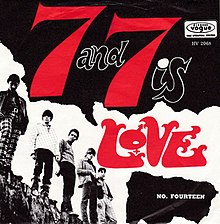7 and 7 Is
| "7 and 7 Is" | ||||
|---|---|---|---|---|
 |
||||
| Single by Love | ||||
| from the album Da Capo | ||||
| B-side | "No. Fourteen" | |||
| Released | July 1966 | |||
| Format | 7" | |||
| Recorded |
|
|||
| Genre | ||||
| Length | 2:15 | |||
| Label | Elektra | |||
| Writer(s) | Arthur Lee | |||
| Producer(s) | Jac Holzman | |||
| Love singles chronology | ||||
|
||||
"7 and 7 Is" is a song written by Arthur Lee and recorded by his band Love on June 20, 1966, at Sunset Sound Recorders in Hollywood. It was produced by Jac Holzman and engineered by Bruce Botnick.
The song was released as the A-side of Elektra single 45605 in July, 1966. The B-side was "No. Fourteen", an out-take from the band's earlier recordings. "7 and 7 Is" made the Billboard Pop Singles chart on July 30, 1966, peaking at number 33 during a ten-week chart run and becoming the band's highest-charting hit single. The recording also featured on the band's second album, Da Capo.
The song drew inspiration from a high school sweetheart of Arthur Lee's, Anita "Pretty" Billings, who shared his birthday, March 7. It also describes Lee's frustration at teenage life - the reference to "in my lonely room I'd sit, my mind in an ice cream cone" being to wearing (in reality or metaphorically) a dunce's cap. Describing how the song came to him, Lee stated: "I was living on Sunset and woke up early one morning. The whole band was asleep. I went in the bathroom, and I wrote those words. My songs used to come to me just before dawn, I would hear them in dreams, but if I didn't get up and write them down, or if I didn't have a tape recorder to hum into, I was through. If I took for granted that I could remember it the next day—boink, it was gone."
It took a great deal of work to record, with Love's drummer, Alban "Snoopy" Pfisterer, being challenged with its frantic demands after 30 takes or so, and being replaced on drums, intermittently, by Arthur Lee himself. In an interview for John Einarson's book Forever Changes (pg 117), lead guitarist Johnny Echols credits the drumming on the released record to Pfisterer. In a 1989 interview, Arthur Lee stated that he himself taught Pfisterer how to play the part, and that the final record featured Pfisterer. In what has been described as a "flirtation" with musique concrète, the song climaxes in an apocalyptic explosion - the supposed sound of an atom bomb - before a peaceful conclusion, in a blues form, which then fades out. Although many listeners thought that the explosion at the end of the song was a reverb unit being kicked or dropped, it was (according to the engineer Bruce Botnick in "Forever Changes" book, page 118), in actuality, taken from a sound effects record. He speculated that it was a recording of a gunshot slowed down. For live performances, the explosion was reproduced by kicking a reverb unit.
...
Wikipedia
